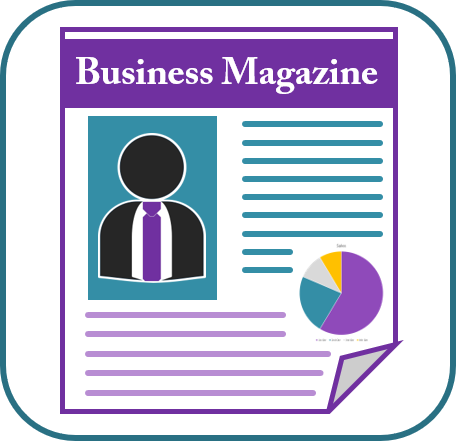
The first entry is a sample footnote/endnote as it would appear the first time that a work is cited. Remember, while our examples begin with “1.”, notes should be numbered based on the order they occur in the paper.
The second entry is a shortened version for subsequent notes from the same source.
The third entry is the bibliographic citation that will be found at the end of the work. A bibliography is alphabetized by author’s last name.
Magazines (Print)
NOTE: For magazine articles, the notes should reference the specific pages quoted/summarized. However, unlike journal articles, pages numbers for magazine articles can be omitted from the bibliographic citation.
1. Judith Thurman, “The Candidate's Wife,” The New Yorker, September 27, 2004, 132.
2. Thurman, “The Candidate's Wife,” 126-128.
Thurman, Judith. “The Candidate's Wife.” The New Yorker, September 27, 2004.
Magazines (Online)
NOTE:In cases when the news article was consulted online, include the URL instead of the page numbers. The URL should also appear in the bibliography.
1. Judith Thurman, “The Candidate's Wife,” The New Yorker, September 27, 2004, https://www.newyorker.com/magazine/2004/09/27/the-candidates-wife.
2. Thurman, “The Candidate's Wife,” 126-128.
Thurman, Judith. “The Candidate's Wife.” The New Yorker, September 27, 2004. https://www.newyorker.com/magazine/2004/09/27/the-candidates-wife.
Newspapers
NOTE: Newspaper articles, whether in print or online, do not receive page numbers. Citing the section of the paper is also unnecessary.
1. Pascale Bonnefoy, “50 Years Ago, a Bloody Coup Ended Democracy in Chile,” New York Times, September 11, 2023.
2. Bonnefoy, "Bloody Coup."
Bonnefoy, Pascale. “50 Years Ago, a Bloody Coup Ended Democracy in Chile.” New York Times, September 11, 2023.
Newspapers (Accessed Online)
NOTE: Citing a newspaper article accessed online is functionally the same as citing a physical paper, with the exception of the URL being added to the first note and bibliography. If an online database such as LexisNexis was used to access the article, reference that instead of the URL.
1. Pascale Bonnefoy, “50 Years Ago, a Bloody Coup Ended Democracy in Chile,” New York Times, September 11, 2023, https://www.nytimes.com/2023/09/11/world/americas/chile-coup-50-anniversary.html.
2. Bonnefoy, "Bloody Coup."
Bonnefoy, Pascale. “50 Years Ago, a Bloody Coup Ended Democracy in Chile.” New York Times, September 11, 2023. https://www.nytimes.com/2023/09/11/world/americas/chile-coup-50-anniversary.html
Unsigned Articles
NOTE: For unsigned articles, in your bibliography, put the name of the periodical/website first and then the title. If the article was accessed online, add the URL after the date.
1. "Media Flea Circus," Tattler, August 29, 2002.
2. "Media Flea Circus," Tattler.
Tattler. "Media Flea Circus." August 29, 2002.
Blogs
NOTE: Online-only news sites and blogs are treated no differently than magazines, except that the URL should always be included. Always make sure that online sources are properly evaluated.
1. Sabrina Imbler, “These Orangutans May Not Be Beatboxing But They’re Definitely Doing Something,” Defector, June 27, 2023, https://defector.com/these-orangutans-may-not-be-beatboxing-but-theyre-definitely-doing-something.
2. Imbler, “Orangutans.”
Imbler, Sabrina. “These Orangutans May Not Be Beatboxing But They’re Definitely Doing Something.” Defector, June 27, 2023. https://defector.com/these-orangutans-may-not-be-beatboxing-but-theyre-definitely-doing-something.
Reader Comments
NOTE: Reader comments posted online should be cited in the notes, but not in the bibliography. For clarity, they should follow a citation for the article being commented upon.
3. Rip Danger, Life Enthusiast, June 27, 2023, comment on Imbler, "Orangutans."
